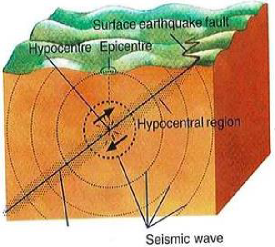1. Earthquakes
An earthquake in simple words is shaking of the earth. It is caused due to release of energy, which generates waves that travel in all directions.
The release of energy occurs along a fault. A fault is a sharp break in the crustal rocks. Rocks along a fault tend to move in opposite directions. As the overlying rock strata press them, the friction locks them together. However, their tendency to move apart at some point of time overcomes the friction. As a result, the blocks get deformed and eventually, they slide past one another abruptly. This causes dissipation of energy, and the energy waves travel in all directions.
The point where the energy is released is called the focus of an earthquake, alternatively, it is called the hypocentre. The energy waves travelling in different directions reach the surface. The point on the surface, nearest to the focus, is called epicentre. It is the first one to experience the waves. It is a point directly above the focus.

